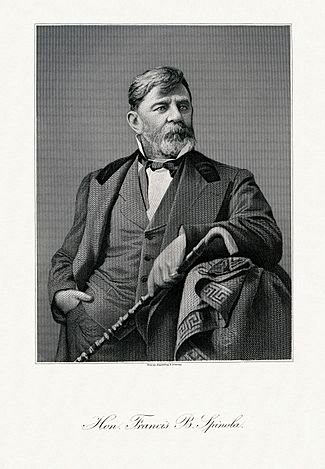Francis B. Spinola facts for kids
Quick facts for kids
Francis B. Spinola
|
|
|---|---|
|
BEP engraved portrait of Francis B. Spinola
|
|
| Member of the U.S. House of Representatives from New York's 10th district |
|
| In office March 4, 1887 – April 14, 1891 |
|
| Preceded by | Abram S. Hewitt |
| Succeeded by | William Bourke Cockran |
| Member of the New York Senate from the 3rd district |
|
| In office 1858–1861 |
|
| Preceded by | Dan Sickles |
| Succeeded by | Henry C. Murphy |
| Personal details | |
| Born | March 19, 1821 Old Field, Long Island, New York |
| Died | April 14, 1891 (aged 70) Washington, D.C. |
| Resting place | Green-Wood Cemetery, Brooklyn, New York |
| Political party | Democratic |
| Military service | |
| Allegiance | United States of America Union |
| Branch/service | United States Army Union Army |
| Rank | |
| Commands | "Spinola Brigade" (Second Brigade, Second Division, Third Army Corps) |
| Battles/wars | American Civil War |
Francis Barretto Spinola (born March 19, 1821 – died April 14, 1891) was an important American leader. He was a politician and a military general. Many people believe he was the first Italian American to be elected to the United States House of Representatives. He served as a representative for New York from 1887 to 1891. He also fought as a general in the Union Army during the American Civil War.
Contents
Early Life and Political Beginnings
Spinola was born in Old Field, New York, near Stony Brook, New York, on Long Island. He went to Quaker Hill Academy. After studying hard, he passed the exam to become a lawyer. He then started his own law practice in Brooklyn.
He began his political career as an alderman in Brooklyn. He was elected in 1846, 1847, and again in 1849, serving for four years. By 1854, he was a respected citizen. He even joined a special police force to help keep order in New York City.
Spinola was a member of the Democratic Party. He served in the New York State Assembly in 1856. Later, he was a member of the New York State Senate from 1858 to 1861. He also attended the 1860 Democratic National Convention.
Military Service in the Civil War
When the American Civil War started, Spinola was a commissioner for New York Harbor. He joined the volunteer army in New York and became an officer. On October 2, 1862, he was made a brigadier general of Volunteers.
General Spinola led two missions to help lift the Confederate siege of Washington, North Carolina. From July to October 1862, he created and organized a group of four regiments. This group became known as Spinola's Empire Brigade.
After the Battle of Gettysburg, Spinola took command of the New York "Excelsior Brigade" on July 11, 1863. This was part of the Third Army Corps. His brigade led Union troops in the Battle of Wapping Heights on July 23. During this battle, 18 of his men were killed. General Spinola himself was wounded. He was honorably released from service in August 1865.
Life After the War and Later Politics
After the Civil War, Spinola worked as a banker and insurance agent. He became an important person among the growing Italian immigrant community in New York City.
He returned to the State Assembly in 1877, 1881, and 1883. From 1887 to 1891, he served as a U.S. Representative for New York's 10th District.
Francis B. Spinola died in office in Washington, D.C., on April 14, 1891. He passed away from pneumonia. His funeral was held at the Immaculate Conception Church. He was buried at Green-Wood Cemetery in Brooklyn, New York.
Family Background
Francis Barretto Spinola's father was João Leandro Spinola. He was born in 1782 on Madeira Island, Portugal. He was a merchant and later became known as John Leander Spinola. His mother was Elizabeth Phelan (1790–1873). She was the daughter of Captain John Phelan. Captain Phelan served in the American Revolutionary War.
João Leandro Spinola and Eliza Phelan were married on June 18, 1808, in New York. The Spinola family originally came from the city of Genoa, Italy. They moved to Madeira Island in the late 1400s or early 1500s as merchants.
Francis Spinola had an older brother named John Leander Spinola. He also had a younger brother, Douglas A. Spinola. He had three sisters: Angelina, Louisa, and Ann Eliza. General Spinola provided for his sister Ann Douglass until his death.
General Francis Spinola married Elizabeth Nancy Glazebrook. She was from Kings, Saratoga County, New York. They married on May 7, 1855, in New York City. Eliza N. Spinola passed away five years after her husband, in 1896.
See also
 In Spanish: Francis Barretto Spinola para niños
In Spanish: Francis Barretto Spinola para niños
- List of American Civil War generals (Union)
- List of United States Congress members who died in office (1790–1899)



